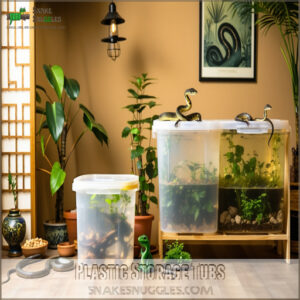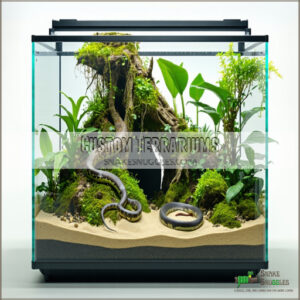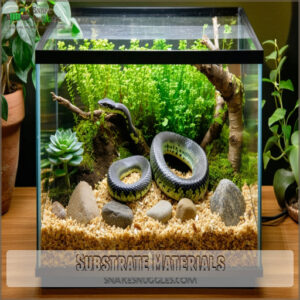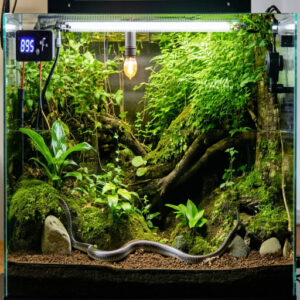This site is supported by our readers. We may earn a commission, at no cost to you, if you purchase through links.
 Wondering how much do snakes cost? You’ll be surprised! Basic pet snakes like corn and ball pythons range from $50 to $150, with exotic species hitting $1,000.
Wondering how much do snakes cost? You’ll be surprised! Basic pet snakes like corn and ball pythons range from $50 to $150, with exotic species hitting $1,000.
But that’s just the start. You’ll need to budget for an enclosure ($100-$500), heating setup, and initial vet visits.
Monthly food costs run $20-$40, depending on your snake’s size.
Adoption is another wallet-friendly option, with fees around $15-$25. Remember, it’s not just about the initial price tag – ongoing care matters most.
Want a budget-friendly snake? Smaller species and DIY setups can help you save some serious cash while scoring a scaly companion.
Table Of Contents
- Key Takeaways
- How Much Do Snakes Cost?
- One-Time Costs of Owning a Snake
- Enclosure and Setup Expenses
- Heating and Lighting Requirements
- Feeding Costs and Considerations
- Ongoing Maintenance and Healthcare Expenses
- Total Cost of Ownership Factors
- Budget-Friendly Snake Ownership Tips
- Frequently Asked Questions (FAQs)
- How much does a pet snake cost?
- How much does it cost to keep a snake?
- How much does snake food cost?
- Is it expensive to own a snake?
- How much does a new snake cost?
- How much does a beginner snake cost?
- Are snakes hard to own?
- Can you buy a snake as a pet?
- Is it illegal to own a snake?
- Are snakes more expensive than cats?
- Conclusion
Key Takeaways
- You’ll need to budget beyond the snake’s purchase price, with initial setup costs ranging from $100 to $500 for enclosure, heating, and accessories.
- Your ongoing monthly expenses will likely run $50-$100, covering food ($20-$40), habitat maintenance, and potential veterinary care.
- Snake prices vary widely, from $50 for basic corn snakes to $1,000 for exotic species, so you’ll want to research specific breed costs before committing.
- You’ll save money by choosing smaller snake species, creating DIY enclosures, and practicing preventative care to minimize unexpected veterinary expenses.
How Much Do Snakes Cost?
While dreaming of a slithery companion, know that snake prices can zigzag from $50 to $1,000.
Corn snakes start cheaper at $50-$150, while ball pythons range from $50 to $500.
Hidden costs lurk beyond the initial price tag. Factor in unexpected expenses like vet visits and habitat setup when planning your long-term budget.
Pro tip: buying from a reputable breeder might cost more upfront but saves on future snake care expenses.
Understanding snake ownership costs is essential for preparing a suitable environment for your pet.
One-Time Costs of Owning a Snake
When you’re thinking about bringing a snake home, you’ll need to budget for more than just the snake itself.
From the enclosure and heating setup to initial vet visits, your one-time costs can range from $100 to $500, depending on the snake species and your chosen habitat.
Adoption Fees
Looking to adopt a snake? Reptile rescue shelters offer affordable options, with adoption fees typically ranging from $15 to $25.
These programs aren’t just budget-friendly—they’re a win-win for conscientious pet owners. Support animal welfare.
- Support animal welfare
- Get a pre-screened, health-checked companion
- Save money compared to pet store prices
Shelter staff often evaluate your snake care knowledge, ensuring you’re ready to provide a loving, responsible home for your new scaly friend.
When considering corn snake adoption options, researching and understanding the needs of your potential new pet is key.
Breeder or Pet Store Prices
Traversing snake prices can feel like a wild ride, with options ranging from $15 to $1,000.
Pet stores like Petco and online retailers like Backwater Reptiles offer ball pythons and corn snakes at competitive rates.
Breeder fees vary based on snake morph, species, and reputation.
Always factor in shipping costs and prioritize health over the lowest price.
When searching for a reptiles for sale option, consider the overall cost and the benefits of purchasing from a reputable dealer.
Species-specific Costs
If you’re eyeing a pet snake, four species offer exciting options at different price points.
- Ball pythons range from $50-$500, perfect for beginners
- Corn snakes cost $50-$200, known for gentle temperaments
- Green tree pythons demand $350-$1,000 for exotic appeal
- Hognose snakes sit between $100-$700, with unique personalities
Your snake’s price depends on morph, color genetics, and breed variations.
Enclosure and Setup Expenses
When setting up a home for your new slithery friend, you’ll want to evaluate several enclosure options that match your budget and snake’s needs.
From budget-friendly plastic tubs to fancy custom terrariums, you’ve got plenty of choices that can help you create a comfortable habitat without breaking the bank.
Plastic Storage Tubs
Want a wallet-friendly snake habitat? Plastic storage tubs are your secret weapon! They’re cheap, customizable, and perfect for budget-conscious snake parents.
Just remember: ventilation is key. Drill holes carefully, choose the right size, and transform that basic tub into a cozy snake paradise.
When setting up your snake’s home, consider the importance of an affordable snake tank to guarantee a comfortable and healthy environment.
| Tub Size | Cost Range | Pros |
|---|---|---|
| Small | $10-$20 | Portable |
| Medium | $20-$35 | Versatile |
| Large | $35-$50 | Spacious |
Aquariums
You’ll transform an aquarium into a snake sanctuary with savvy choices and smart budgeting.
Glass tanks offer stunning snake views, but prices bounce from $50 to $250 depending on size and quality.
- Measure your snake’s length before buying
- Check for sturdy, scratch-free tank construction
- Prioritize secure, well-ventilated designs
- Calculate long-term maintenance costs
Used tanks can slash expenses, but inspect carefully, as your reptilian buddy needs a safe, comfortable home that won’t break the bank.
Remember, a good habitat is an investment in your snake’s health and happiness.
To guarantee the best environment, consider proper snake enclosure setup to keep your pet healthy and thriving.
Custom Terrariums
Three top-tier companies offer custom snake terrariums that’ll make your reptile’s home a dream.
They are Custom Cages, Cornel’s World, and Vision Cages that craft enclosures suited to your snake’s specific needs.
You’ll get durable, stackable designs with options like tempered glass or wire doors.
Build a habitat that mimics your snake’s natural environment, complete with roots, sand, and rocks.
When designing your custom terrarium, consider the importance of proper snake terrarium setup to guarantee your pet’s health and well-being.
Substrate Materials
After crafting a custom terrarium, your next move is picking the perfect substrate for your scaly buddy.
Snake bedding isn’t just about looks – it’s about creating a comfortable home.
Here’s what matters:
- Comfort level for your snake
- Humidity control
- Easy cleaning and maintenance
Coconut fiber, aspen shavings, and reptile carpet each bring something special to your snake’s habitat.
Choose wisely!
Accessories (hides, Water Bowls, Decorations)
Every snake needs a killer pad that feels like home.
Your snake’s hides, water bowls, and decorations aren’t just accessories – they’re essential comfort zones.
Here’s how to deck out the perfect snake sanctuary:
- Hides: Create secure, snug spaces that scream "privacy" using air-dry clay or foam with safe acrylic paint.
- Water Bowls: Choose sturdy designs that won’t tip over during snake shenanigans.
- Decorations: Use non-toxic materials like silicone sealant and sterilized natural branches.
- DIY Décor: Get creative with affordable, snake-safe materials to personalize their tank.
Heating and Lighting Requirements
When you bring a snake home, you’ll need to set up the right heating and lighting to keep your scaly friend happy and healthy.
Your snake’s environment is essential, so you’ll want to invest in the right equipment to maintain the perfect temperature and light conditions for your new pet.
Reptile Heating Pad
Here’s a focused, precise guide to reptile heating pads for snake owners:
In snake care, a quality heating pad isn’t just an accessory—it’s a lifeline.
Your scaly friend needs consistent warmth to stay healthy.
A variety of reptile heating pads are available.
Heating options range from $15 to $100, with prices reflecting pad sophistication.
Choose wisely: under-tank heaters work great for small spaces, while digital heat sources offer precise temperature control.
Pro tip? Always prioritize your snake’s safety when selecting a heating source.
Thermostats for Heat Regulation
After your heating pad warms things up, a reliable thermostat becomes your snake’s climate control guardian.
These smart devices prevent wild temperature swings that could stress your scaly buddy.
Grab a reptile-specific model with a precise probe, and you’ll dial in the perfect warmth, think of it like a temperature bodyguard for your slithery friend’s cozy home.
UVB Lights for Certain Species
Ready to give your snake the perfect lighting?
UVB lights aren’t just fancy decorations—they’re lifelines for some scaly friends.
Think of them as miniature suns bringing warmth and health to your reptilian buddy.
- Different snakes need different UV levels
- Helps prevent bone diseases
- Mimics natural habitat conditions
- Boosts overall snake wellness
Smart lighting can mean the difference between a thriving snake and one struggling to stay healthy.
Veterinarian Consultation for Specific Needs
A trusted reptile vet is your snake’s health guardian, offering essential insights into its well-being.
Specialized snake veterinary care helps you navigate complex medical landscapes and prevent potential health disasters.
- Decode intricate snake health requirements
- Identify species-specific medical risks
- Develop emergency treatment strategies
- Budget wisely for medical interventions
Professional guidance saves you money and keeps your slithery friend thriving, with specialized snake veterinary care being a key factor, and it helps in prevent potential health disasters.
Ongoing Electricity Bills and Potential Equipment Replacements
A serpent’s habitat can silently drain your wallet through ongoing electricity bills. Your heating setup might zap more energy than you’d expect, with snake enclosures consuming 20-60 watts daily.
Invest in pulse thermostats and low-wattage ceramic heat emitters to slice energy consumption by 20-30%.
Clever insulation tricks like foam boards can help retain heat, reducing power needs. Budget for equipment replacements every 1-2 years, and choose energy-efficient options to keep both your snake and bank account comfortable.
Feeding Costs and Considerations
When you bring a snake home, you’ll want to know exactly what it’ll cost to keep your slithery friend well-fed and happy.
Understanding feeding costs is key to being a responsible pet owner. Your snake’s diet depends on its species, age, and size.
Mice and Rats Costs
After keeping your snake toasty warm, it’s time to talk grub!
Rodent prices can make or break your budget.
Here’s the scoop on feeding your slithery friend:
- Fuzzy mice range from $1.50-$2 each
- Bulk deals can save serious cash
- Frozen mice offer convenience and safety
- Reptile expos have competitive pricing
- Breeding your own can cut costs dramatically
Snake feeding isn’t cheap, but smart shopping helps, and considering bulk deals can make a significant difference.
Feeding Frequency
Snake-eating schedules are a bit like personal workout routines – unique to each individual’s needs.
Your slithery friend’s appetite depends on age, species, and metabolism.
Here’s a quick feeding frequency guide to keep your pet healthy and happy:
| Age Group | Feeding Frequency | Notes |
|---|---|---|
| Juvenile | Every 5-7 days | Higher metabolism |
| Adult | Every 10-14 days | Less frequent meals |
| Large Species | Bi-weekly | Slower digestion |
| Small Species | Weekly | More frequent feeding |
Special Dietary Needs
After mastering feeding frequency, you’ll want to zero in on your snake’s unique dietary needs.
Different species crave different nutrition profiles! Here’s what savvy snake owners know:
- Pythons need whole prey with calcium boosts
- Boas prefer pre-killed meals with vitamin sprinkles
- Colubrids enjoy food variety without many supplements
- Specific feeding requirements vary by snake type
Matching your pet’s diet keeps them healthy and thriving with a diet that meets their unique dietary needs.
Veterinarian Consultation for Feeding Schedule
A wise vet is your go-to guide for nailing your snake’s feeding schedule.
They’ll decode your pet’s unique dietary needs, crafting personalized snake nutrition plans that keep your slithery friend healthy.
Expect expert advice on prey sizes, feeding frequencies, and growth tracking.
From ball pythons to corn snakes, a snake vet makes certain you’re not just feeding, but truly nourishing.
These health checks might seem like an extra cost, but they’re your secret weapon against potential nutritional pitfalls.
Ongoing Maintenance and Healthcare Expenses
When you bring a snake home, you’ll need to budget for more than just the initial purchase price.
Your ongoing costs will include food, vet care, habitat maintenance, and essential equipment that keeps your scaly friend healthy and happy.
Food Costs (varies by Snake Size and Species)
You’ll want to budget smartly for your snake’s meals, considering rodent prices range from $2-$10 per mouse, impacting your yearly snake food costs.
Here’s how to manage feeding expenses:
- Buy frozen mice in bulk for savings
- Match prey size to your snake’s girth
- Consider monthly food budget of $20-$40
- Watch for wholesale rodent pricing
- Track feeding frequency by snake species
Smart shopping keeps your slithery friend well-fed without breaking the bank, which is essential for budget smartly and snake food costs.
Healthcare Expenses (vet Visits, Medications)
Brace yourself for the reality of snake healthcare costs! Annual vet visits for exotic reptile specialists typically run $45-$75, with emergency treatments potentially skyrocketing.
Medications for parasites or infections can range from $20-$200, depending on the specific issue. Consider exotic pet insurance (averaging $200-$500 annually) to cushion unexpected medical expenses.
Pro tip: Stash away $300-$500 in an emergency fund for your slithery friend’s potential healthcare needs. Preventative care is your wallet’s best friend in snake ownership, and having a fund set aside can help mitigate the financial impact of emergency treatments.
Enclosure Maintenance (cleaning, Substrate Replacement)
Grime’s the enemy in your snake’s kingdom.
Regular tank sanitation keeps your slithery friend healthy and happy, and regular tank sanitation is crucial for this. Swap out substrate every few weeks, using affordable cleaning supplies like newspapers or coconut fiber.
Waste removal prevents bacteria and odors, maintaining the perfect snake home environment, which is essential for your snake’s well-being, and this is achieved through budget-friendly upkeep. Budget-friendly upkeep means staying on top of your enclosure’s cleanliness.
Heating and Lighting Costs
After scrubbing your snake’s habitat clean, you’ll want to turn your attention to keeping them cozy and warm. Temperature control isn’t just a luxury—it’s survival for your scaly friend.
Smart heating sources can make all the difference without crushing your wallet. Heat cables and heating pads are snake-saving heroes, drawing just 15-24 watts. Ceramic heat emitters work magic by providing consistent warmth without bright lights.
Pro move? Invest in a quality thermostat that keeps your snake comfortable and your energy bill lean.
Equipment Cost Range Energy Efficiency
Your reptilian buddy will thank you for creating the perfect climate – no sweat, no stress.
Total Cost of Ownership Factors
When you’re thinking about getting a snake, you’ll want to understand all the costs that come with snake ownership.
From the initial purchase to ongoing care, there’s more to budget for than just the snake itself, so let’s break down what you’ll need to plan financially.
Initial Investment
Eyeing a slithery companion? Your snake’s initial investment goes beyond a simple price tag.
Costs can slither from $15 to $1,000+, depending on species and morph. Before diving into snake ownership, consider these key factors:
- Adoption fees and breeder prices
- Species-specific purchase costs
- Enclosure and setup expenses
- Veterinary consultation needs
Smart pet parents research thoroughly, understanding that the cost of buying a snake involves more than just the creature itself, it’s about a healthy and happy relationship, and your initial investment sets the stage for a reptilian relationship.
Your initial investment sets the stage for a healthy, happy reptilian relationship.
Feeding Costs
Feeding your snake isn’t just about filling its belly—it’s about smart meal planning.
Rodent prices range from $2 to $10 each, with young snakes munching weekly and adults dining biweekly.
Bulk frozen mice can slash your snake food prices, keeping both your wallet and pet happy, which is why your nutrition strategy matters big time.
Enclosure and Setup
After feeding your snake, it’s time to create their perfect pad.
Your snake enclosure isn’t just a home—it’s a sanctuary.
From budget-friendly plastic tubs to custom terrariums, focus on recreating their natural habitat.
Snake tank cost varies, but personalization matters most.
Invest in right-sized tanks, comfy snake hides, and smart ventilation systems that’ll make your slithery friend feel like royalty.
Heating and Lighting
Your snake’s habitat needs the right heating and lighting to keep them happy and healthy.
Here’s what you’ll want to know:
- Choose energy-efficient heat sources
- Invest in a reliable thermostat
- Consider multiple lighting options
Reptile heating pads with thermostats are a snake owner’s best friend.
They provide belly heat safely and prevent overheating.
Ceramic heat emitters and UVB lights help maintain the perfect temperature without turning your snake’s home into a sauna.
The right setup keeps your scaly friend comfortable and your electricity bill in check.
Ongoing Costs
Wondering how deep your wallet needs to be for a snake’s monthly maintenance?
Expect to shell out $50 to $100 for ongoing snake expenses.
These snake expenses cover critical needs like food, substrate, heating, and potential vet care.
Budget carefully—those ongoing costs of snake upkeep can slither up on you faster than you’d imagine, turning your pet passion into a pricey adventure, with monthly maintenance costs that require careful planning.
Budget-Friendly Snake Ownership Tips
Want to own a snake without breaking the bank?
You’ll be surprised how easy it can be to care for a scaly friend on a budget, especially when you know the right tips and tricks.
Choose a Smaller Snake
Want to keep your pet snake budget-friendly? Smaller snake species are your ticket to wallet happiness!
Here’s why:
- Lower initial prices ($15-$100)
- Minimal feeding costs
- Compact habitat requirements
- Easier handling and care
Ribbon snakes and corn snakes are budget-friendly champions that won’t break the bank.
These pint-sized serpents demand less space, making DIY enclosures a breeze.
Their small size translates to reduced food expenses and simpler maintenance.
By choosing a compact snake breed, you’ll save on space savings and lower expenses while still enjoying a fascinating pet.
Your scaly companion can be affordable and awesome without compromising on the reptilian fun!
Create Own Enclosure Décor, Hides, and Substrate
How could you craft a snake paradise without emptying your wallet?
DIY snake decor is easier than you think!
Here are some budget-friendly snake enclosure hacks:
- Repurpose cardboard boxes as cozy snake hides
- Collect free driftwood from safe outdoor spaces
- Use coconut fiber or shredded paper as affordable substrate
- Create custom snake hides from PVC pipes
Your scaly friend doesn’t need fancy accessories.
Natural materials like smooth rocks and clean branches can transform an ordinary enclosure into a reptilian retreat that’s both comfortable and cost-effective.
Avoid Unnecessary Vet Visits
After crafting custom hideouts, your budget-savvy journey continues with preventive snake care.
Spot early warning signs by tracking weight, checking skin condition, and observing behavior patterns.
Regular home health checks catch potential issues before they become expensive problems.
Watch for lethargy, unusual shedding, or appetite changes, as a keen eye and proactive approach can slash those dreaded vet consultation costs.
Feed Properly for Optimal Health
Keeping your snake healthy starts with nailing its nutrition game.
Rodent-based diets aren’t one-size-fits-all.
Here’s your snake feeding survival guide:
- Match prey size to your snake’s body width
- Choose high-quality frozen rodents
- Follow age-based feeding schedules
- Track portion sizes carefully
- Invest in consistent, reliable food sources
Meal Frequency
Your snake’s health hinges on smart, strategic feeding that keeps them thriving without breaking the bank.
Keep Habitat Clean and Hospitable
In snake care, a spotless habitat isn’t just cleanliness—it’s your snake’s five-star health resort.
Mastering snake hygiene means staying one step ahead of potential health hiccups.
- Spot clean daily: Remove waste and uneaten food quickly, like a detective tracking potential hazards.
- Deep clean quarterly: Sanitize the entire enclosure with reptile-friendly disinfectant and hot water.
- Monitor moisture: Keep humidity levels perfect for your specific snake species.
Your diligent care transforms an enclosure into a thriving, safe sanctuary.
Frequently Asked Questions (FAQs)
How much does a pet snake cost?
You’ll shell out $75 to $500 for a pet snake, with exotic morphs hitting higher prices. Tack on another $300 for habitat, food, and supplies. Budget wisely for your scaly friend’s needs.
How much does it cost to keep a snake?
Curious about snake ownership‘s price tag?
You’ll shell out $300-$1,000 annually.
Costs include the snake ($20-$5,000), habitat setup, food ($2-$10 per meal), heating, and vet care.
Budget wisely for your scaly friend’s needs.
How much does snake food cost?
You’ll spend $2-$10 per feeder mouse or rat.
Young snakes eat weekly, adults every other week.
Bulk frozen rodents online can cut costs.
Expect around $20 monthly for snake food, depending on your snake’s size and appetite.
Is it expensive to own a snake?
Owning a snake isn’t cheap, but it’s manageable if you plan ahead.
Initial costs range from $100 to $500, with monthly expenses around $
Budget for food, habitat, and vet care to keep your scaly friend healthy and happy.
How much does a new snake cost?
You’ll find pet snakes priced between $20 and $5, Basic morphs typically cost $30-$100, while exotic breeds can run thousands. Ball pythons range from $60-$700, and most starter snakes hover around $75-$
How much does a beginner snake cost?
You’ll need about $50-$200 for a beginner snake like a corn snake or ball python.
Toss in another $100-$300 for a basic setup, and you’re ready to welcome your scaly new friend home.
Are snakes hard to own?
Thinking of a slithery friend?
Snakes aren’t tough to own if you’re prepared, they’re low-maintenance pets that need specific care.
With research and commitment, you’ll master snake care and enjoy a unique, fascinating companion.
Can you buy a snake as a pet?
You can definitely buy a snake as a pet.
With proper research, care, and budget, pet snakes make unique companions.
Check local pet stores, reptile breeders, and exotic pet shops for your perfect slithery friend.
Is it illegal to own a snake?
In the shadows of legality, snake ownership dances like a serpent’s sway.
You’ll need to check local laws—some states restrict certain species.
Research your area’s regulations to confirm you’re on the right side of the law.
Are snakes more expensive than cats?
You’ll shell out more cash for a cat than a snake.
Cats cost $500-$1,000 yearly, while snakes run $400-$500 annually.
Your scaly friend’s cheaper to keep, with lower food and vet bills.
Conclusion
Surprisingly, understanding how much do snakes cost isn’t just about dollars—it’s about commitment.
You’ll discover that snake ownership is more than an initial price tag; it’s an investment in a unique companion.
Whether you’re budgeting for a corn snake or dreaming of an exotic species, remember: smart planning prevents financial surprises.
Your wallet and your scaly friend will thank you for doing your homework before bringing home your new reptilian buddy, which is a result of smart planning.
- https://www.reddit.com/r/snakes/comments/wevo1d/what_is_the_average_cost_to_owning_a_pet_snake/
- https://www.xyzreptiles.com/how-much-is-a-pet-snake/
- https://pangovet.com/pet-lifestyle/snakes/snake-cost/
- https://www.petco.com/shop/en/petcostore/category/reptile/pet-reptiles/snakes
- https://a-z-animals.com/animals/snake/snake-facts/pet-snakes-cost/




















